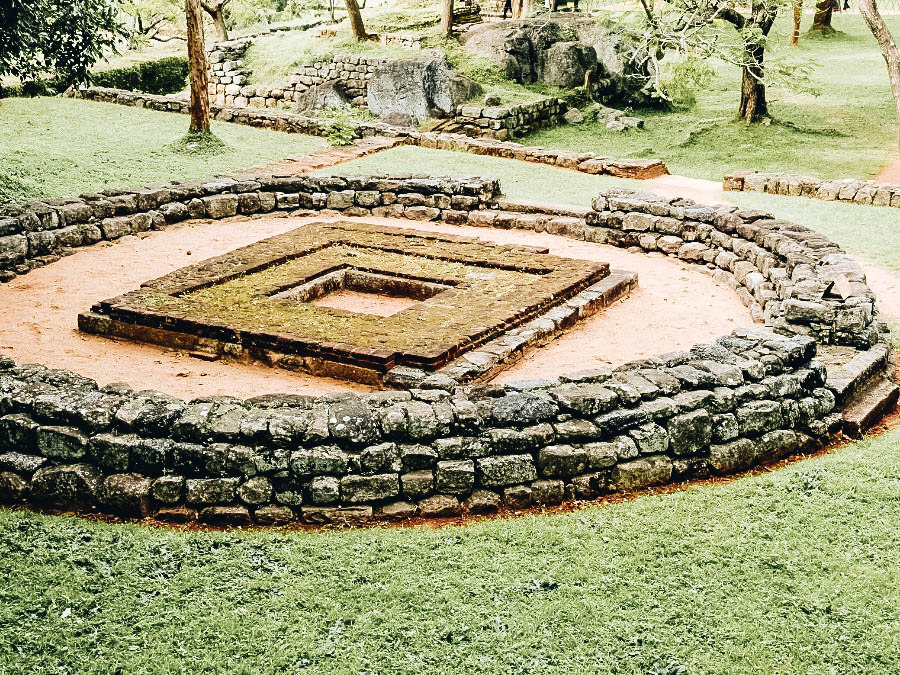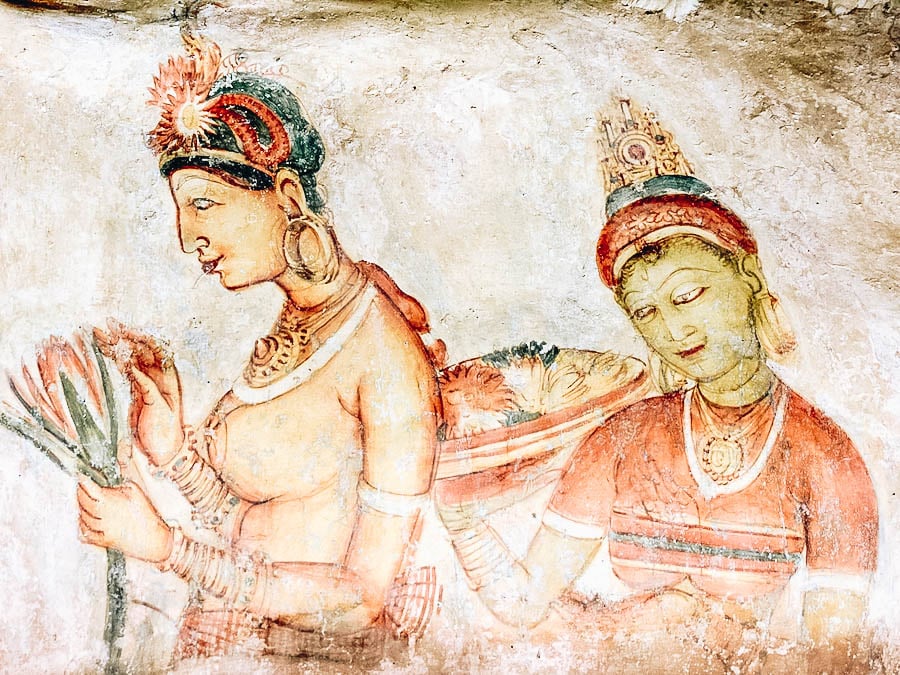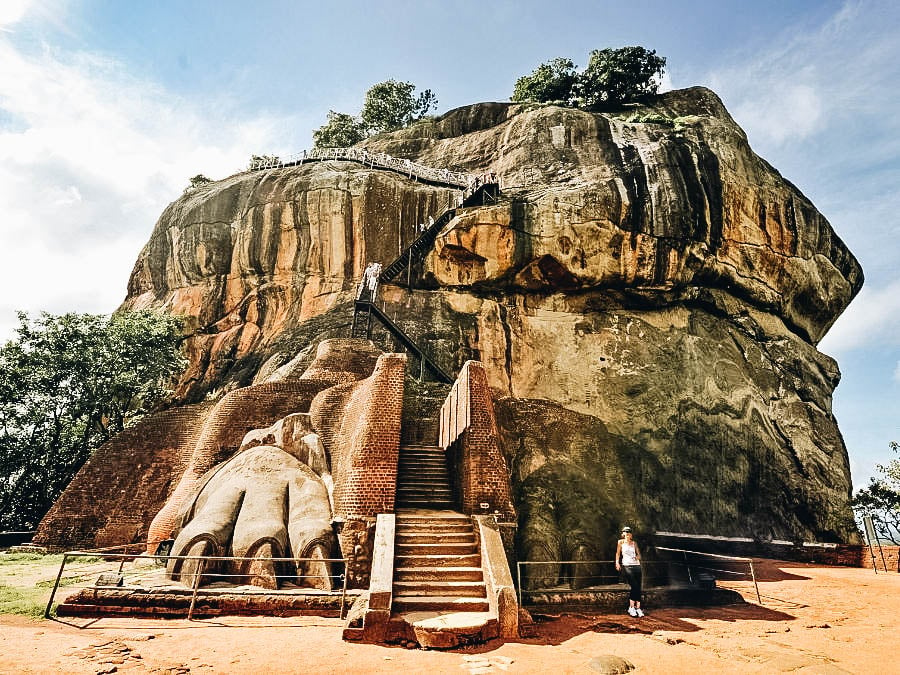Even before you get to the top, it’s undeniable that Sigiriya in Sri Lanka, an ancient fortress known more affectionately as the Lion Rock, is a magnificent and impressive site. Designated as a UNESCO World Heritage site in 1982, this rock, towering at 200 meters above water, has obtained a lot of history, story and legend, and archeological wonder throughout its many years of existence. Although not an easy climb (there’s over 1200 steps!), it’s a site not to be missed when in Sri Lanka.
In this guide, you’ll learn about its history, what the site holds in today, and how you, too, can check climbing Sigiriya off your bucket list.

A Guide to Sigiriya in Sri Lanka (aka: Lion Rock)
History of Sigiriya Fortress
Sigiriya Fortress was built by King Kashyapa I, in the 5th century, at the time of which the area belonged to the Moriya, who were the natives to the Sinhalese dynasty. This fortress played the role of capital to the kingdom, until the king was defeated in 495 A.D. Before the fortress was built, the rock was inhabited by Buddhist monks, and after the passing of the king, it returned to its function as a monastery. However, evidence exists that this area has been lived in since as long ago as the 10th century B.C.
From then on, the capital changed with each short-lived dynasty, until the region was mostly abandoned by the Sinhalese dynasties altogether. It wasn’t until the 19th century that Sigiriya became of any significance again, when it became a military fortress for the kingdom of Kandy. Directly afterwards, it became a site of interest during the colonization of the British Empire, and through the efforts of military officer Jonathan Forbes specifically.
It is generally regarded to be one of the most valuable historical sights in Sri Lanka. The structure of the rock was formed from magma, which came from a now extinct volcano. It’s deemed to have a lot of importance from archaeological perspectives, with the fortress including numerous intriguing features, such as the Mirror wall, which is said to have been so polished once upon a time that the king could see his reflection in it. Additionally, its time as a center for power, however brief, in combination with its remote location, have paved the way to creating a significant legacy to Sigiriya Rock. Not to mention its significance to the Sinhalese cultures.
About Sigiriya in Sri Lanka
As was mentioned, there are many striking features to Sigiriya, which are the reason why it’s quite possibly Sri Lanka’s most visited tourist attraction.
The Gardens
The Gardens are composed of three components: the cave and boulder gardens, the terrace gardens, and the water gardens. Located on the west side of Sigiriya, the water gardens themselves are further divided into three sections, with especially the fountains remaining an impressive sight to see today. But while both the water gardens and the boulder gardens are stunning, it can be said that the terrace gardens are the most impressive among the gardens of Sigiriya in Sri Lanka, complete with a limestone staircase that runs through it. In general, these gardens are worth visiting already simply for the fact they are some of the oldest gardens still existing in the world.

The Rock Palace
This Rock Palace was officially the king’s palace once upon a time. It is also perhaps Sigiriya’s biggest source of pride, and certainly among the biggest reasons why tourists flock to the attraction. Besides the palace, there’s the fortified fortress, as well as numerous rock carvings and sculptures, at this site.
Lion Rock Sigiriya Graffiti
Much of the Lion Rock’s Mirror Wall is covered with ancient graffiti. They were inspired by the frescoes – which you can read more about below – and in a major part feature poetry. These graffiti have been a great help in identifying new words of the Sinhala language.
Boulder Garden of Lion Rock Sigiriya
Unlike the other gardens at Sigiriya, the Boulder Garden is built in a largely asymmetrical fashion. Much of the gardens are also from a time period before Sigiriya ever became of significance to the Sinhalese, having instead been built by the monks who were the original inhabitants of the rock. Sadly, not a lot of this ancient handiwork has lasted through the times to still be admired today, although plenty of artistry and artifacts still remain to be seen today.
Lion Staircase
This staircase was also built by King Kashyapa I, guarding the entrance to his palace. It is located on the northern side and is about all that remains of what was once a much larger structure. At its prime, the staircase was 35 meters high and 20 meters wide.
Palace Complex of Sigiriya Lion Rock
Besides the above-mentioned qualities, the palace complex of Sigiriya Rock also featured impressive frescoes, as well as a cave named “Cobra Hood Cave”. Located within the Boulder Garden, it is a projection representation of a cobra with an open hood. This cave is typically visited on your way back from the site’s summit.
Lion Rock Frescoes
Featured in many essays about Sigiriya and making up a large wall area on the western side of the Lion Rock, these frescoes represent women with flowers in their hands. Specifically, they are located about halfway up the rock. Not many of them have survived up until today, but the ones that have remain as impressive as ever, and a lot of speculation over who these women were continues all the way until today.

Climbing the Steps of Sigiriya
Although climbing up Sigiriya is not difficult per se, it is quite demanding. The rock stands 200 meters above water and there are 1200 steps to be conquered to get up there. Divided into six parts of climbing, the climb gets harder the further into it you get. It can take nearly 2 hours to reach the summit, but frankly you are not in any rush to get there anyway, as there are many attractions, starting with the boulder gardens, scattered on the lower stages of the climb.
To climb Sigiriya during the best possible time, time your trip to January, February, or March, with February being the best of these months. During this time of year, the temperatures are somewhere around 28 to 32C (82-90F), with possible downpours, but mostly in the afternoons and only lasting for a short while. Even during these months, your very best bet is to climb up Sigiriya in the morning hours of the day.

Visiting Nearby Pidurangala Rock
While not as popular to visit as the Lion Rock, Pidurangala Rock is another impressive rock in the region—it’s actually almost as tall as Lion Rock! The attraction is definitely a worthwhile addition to your itinerary for discovering this part of Sri Lanka. The hike up there takes around 30 to 40 minutes, at around moderate difficulty level. It’s said to have also been a Buddhist monastery once upon a time, and there’s still a cave temple located on the trail today. From its summit, you’ll have amazing panoramic views, as well as views of the Sigiriya Fortress.
My Experience Essay
Climbing the 368 stairs to the top of Bartolome island in the Galapagos made my brow trickle with sweat and scaling the 468 stairs of the Florence Duomo made my lungs ache, even the measly 109 steps of the St. Simons Lighthouse in Georgia made me embarrassingly winded. If these were all examples from the past, then what would the 1200 steps of the 200m high Sigiriya rock in Sri Lanka do to me? I was about to find out and I was afraid—very afraid.
Sigiriya is an ancient palace, built in 480AD, located in the central Matale District of Sri Lanka. The UNESCO World Heritage site is known for it’s beautifully landscaped gardens, well-preserved frescos and… a crap load of stairs, all at different anxiety producing levels. But, I was convinced that the experience would be a great addition to my list of the top things to do before you die.
In the early morning, I left the safety of my cozy room at Cinnamon Hotel’s Chaaya Village Habarana to embark on a bus road trip to the the rock. When the tour guide stopped at the bottom of Sigiriya to allow for a photo opportunity, I sensed that I may be in a bit of trouble. It looked HUGE from far away, which meant it would only grow in size as we got closer. All the agonizing pilates classes better help with climbing this rock.
Stepping out of the bus, climbing guides immediately approached each of us asking if we needed any assistance for the trek. We were warned that if you agree to an escort, it will cost you about 1000 rupees ($7.62 usd). I opted to do this climb solo, though some strong man pushing me up sounded like a solid back-up plan.
Crossing the lilypad filled moat, I saw a glimpse of hope for a leisurely climb. The stairs started in sections of about 20 at a time. This was nice. The moss filled steps were picturesque with plenty of landing pads for photo opportunities, monkeys climbed the walls and stray puppies were scampering about. Maybe climbing Sigiriya won’t be so bad after all. Wishful thinking.
Things got a little hairier as I continued on, the steps steeper and sections longer. Then there was a line forming to walk up a spiral metal staircase. In order to see the well preserved Sigiriya frescoes you need to take this route, which I did.
Carrying on I finally reached the Lions Den, a large plateau which acts as a resting ground for explorers. I was warned that if you suffer from vertigo do not go past this point and many climbers opted to turn around here. But, I pressed on hoping that vertigo would not find me.
The stairs hugged the side of the rock and, though they seemed secure, looking down took my breath away in more ways than one. Climbers of all ages were attempting this part of the trek and you could visibly see the fatigue on their faces. I am sure mine looked the same. After stepping foot on the last step of my ascent, before looking at the picturesque view before me, I congratulated myself for the feat that had just been accomplished. And I silently thanked my pilates instructor.
Then, I took a look around to see beauty in a form that I had never witnessed before. At the top was weathered stone ruins, lush green land, a water filled pool and a perfect view. The ideal reward. After taking in the scene, I started my decent, which in some areas was more dangerous than the ascent. Plus, it was a bit of a labyrinth to get out, lacking any signs and each set of stairs leading to another outlook.
In the end, after a total of two and a half hours, there was no choice but to exit through a section of souvenirs (of course), where I gratefully paid 300 rupees ($2.29 USD) for a diet coke, extremely expensive by typical Sri Lankan standards. As I walked towards the bus at the bottom of Sigiriya monkeys roamed close by, most likely wanting a sip of my overpriced diet coke. Not gonna happen.
My legs were wobbling when I climbed the last few stairs for the day, the ones onto the bus, where I plopped into my seat and took a well deserved nap.
Have you already visited this majestic Sigiriya in Sri Lanka or is it in your dreams to do so in the near future? As one of the most fascinating sights to see in all of Asia, surely you’ll want to venture out to Sri Lanka and the Lion Rock one day in your life! Especially when you are in Sri Lanka, you ought not to miss out on visiting this legendary fortress that’s still gaining curiosity among archeologists today.
Sigiriya Essentials
Where is Sigiriya?:
Sigiriya is located in Sri Lanka’s Central Province. More specifically, it is located in the northern part of Matale District. Dambulla is perhaps the closest town to Sigiriya.
How to get to Sigiriya?:
You can get to Sigiriya by bus from Dambulla, from where you can catch the bus at 30 minute intervals every day between 6:30AM and 6:00PM. If you are not staying in Sigiriya for the night, it is highly recommended you do not miss the last bus back to Dambulla as it is still a 25km distance between the two places. You can get to Dambulla from most cities, including Kandy. If you’re coming by car, you can reach Sigiriya by driving on A1 or A6.
The easiest choice would be to join a tour group like the all-inclusive Polonnaruwa & Sigiriya Tour departing from Dambulla.
Opening Time of Sigiriya Lion Rock for Visitors?:
The site opens for visitors at 7AM each day of the week. The last time of admission is at 5PM, and the Lion Rock closes for the day at 5:30PM.
Entrance Fees for Lion Rock Sigiriya:
For foreign tourists, the entrance fee to Sigiriya is $30 USD— and the ancient site is worth every penny!
Can I Buy a Sigiriya Lion Rock Entrance Ticket Online?:
Yes! If you place on venturing to Sigiriya on your own you can book your ticket online in advance at this link!
This post may contain affiliate links. If you make a purchase through my links, I earn a commission that helps to keep this blog running—at no extra cost to you. For more information read my full disclosure.




i was really planning to go thank you for your guide
Thank you for sharing this information its informative